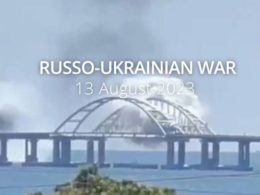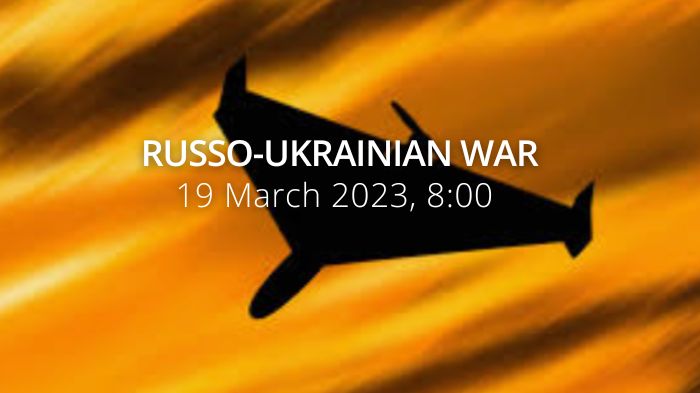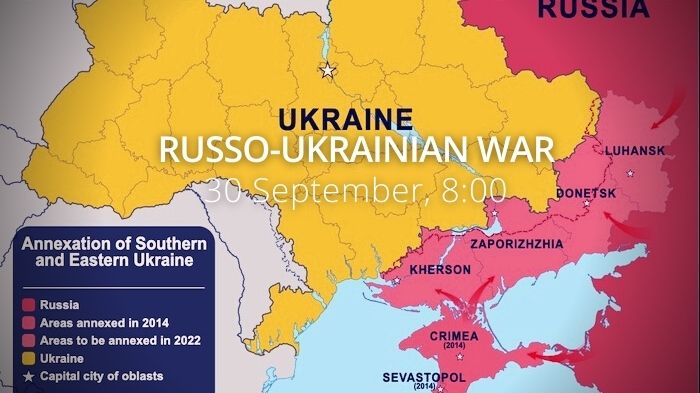Breakthrough at Ukrainian grain negotiations in Istanbul. 16 vessels sail to be loaded with Ukrainian grain. A special coordination center for the Ukrainian grain shipment to be set up in Istanbul. Ukrainian strike aviation has already carried out 1,700 group strikes against Russian forces. Russia repeatedly strikes Ukrainian civilians. Anti-Russian sentiment in occupied Ukraine is leading to Russian and pro-Russian officials being targeted. The US calls for an immediate halt to Russian deportations in Ukraine.
Daily overview — Summary report, July 14
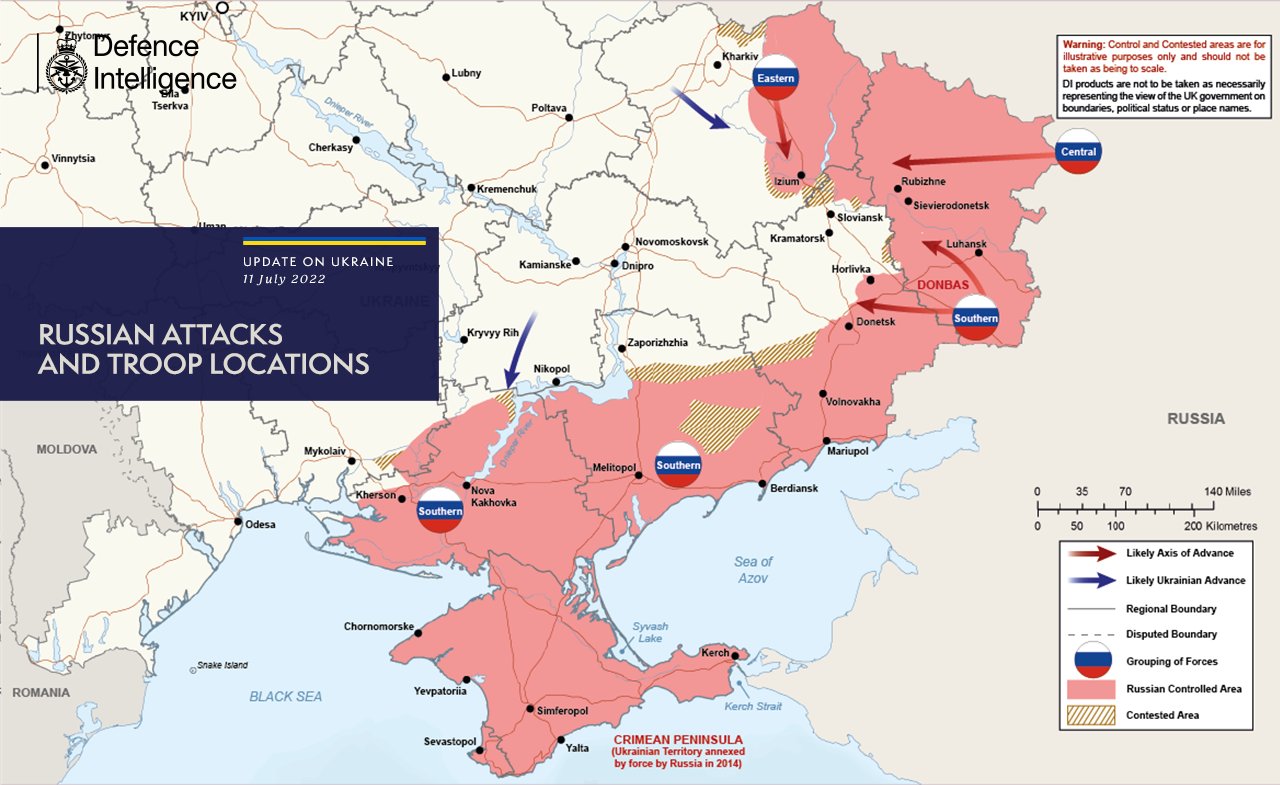
According to military expert Stanislav Haider, as of July 14,
Donetsk Oblast. Heavy fighting continues in the Bohorodychne area. The Ukrainian forces are holding Novoluhanske and the Vuhlehirsk power plant firm. Battles are ongoing in the direction of Soledar, Siversk, and Avdiivka.
South of Donetsk Oblast. The most active is the area of Mariinka where the Ukrainian troops repelled a Russian attack. In the Vugledar area, Ukraine successfully defends the newly liberated villages and positions.
Kharkiv Oblast. There were no changes near the border. A new Russian assault in the Prudianka failed. Ukraine successfully confines the Russian forces by asserting pressure to the west of Izium, disrupting the Russian plans to conduct an assault on Sloviansk.
Zaporizhzhia Oblast. Ukrainian forces resumed active tactical actions in the directions of Vasylivka and Polohy. In response, Russia further reinforced its group of forces: up to 2 Russian battalion-tactical groups (BTG) arrived in the area of Myrne-Novohorivka, one BTG in the area of Polohy-Ozherelne-Basan.
Kherson Oblast. Battles intensified near Snihurivka and at Inhulets as Ukrainian troops are counterattacking and conducting tactical actions to the west of Kherson.
The work of Ukrainian artillery. The Ukrainian artillery troops attacked ammunition depots in Nova Kakhovka (Sokil plant), Horlivka (warehouse of 152 mm shells), Luhansk, Makiivka, Chaplynka.
Map:
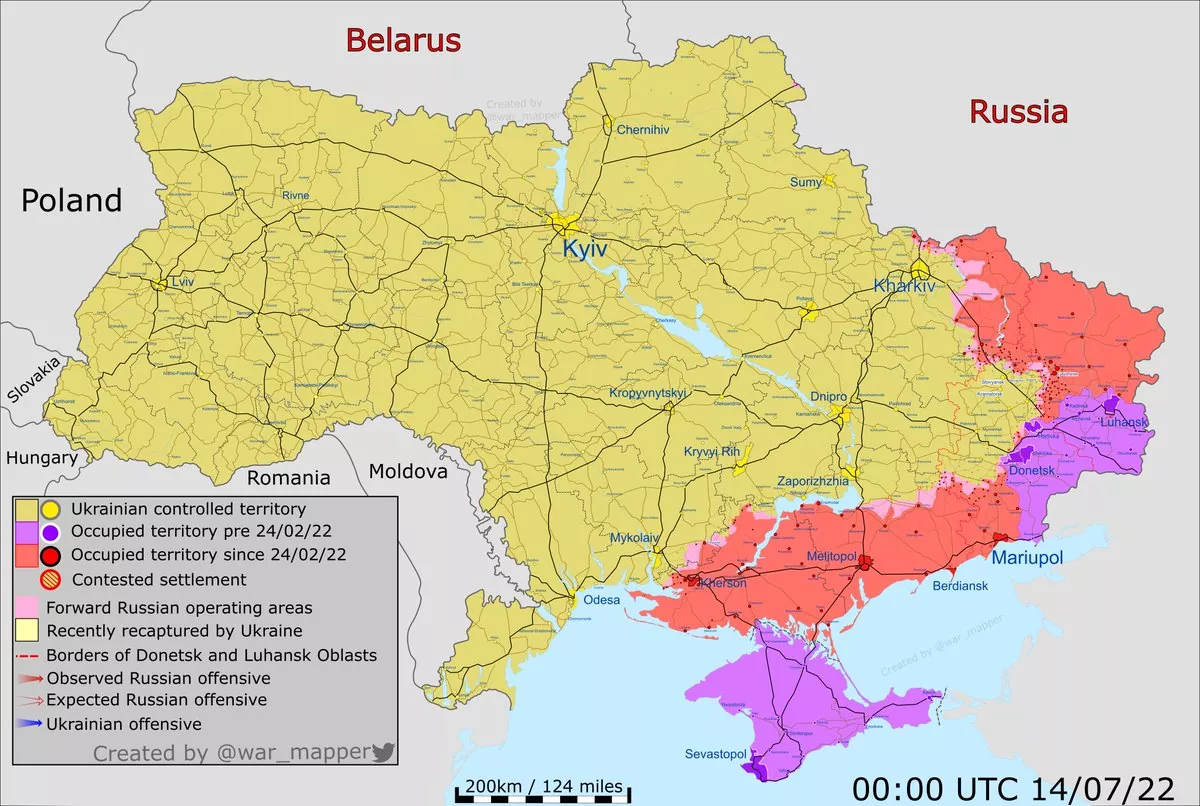
The General Staff’s operational update regarding the Russian invasion as of 06.00 am, July 14, 2022 is in the dropdown menu below.
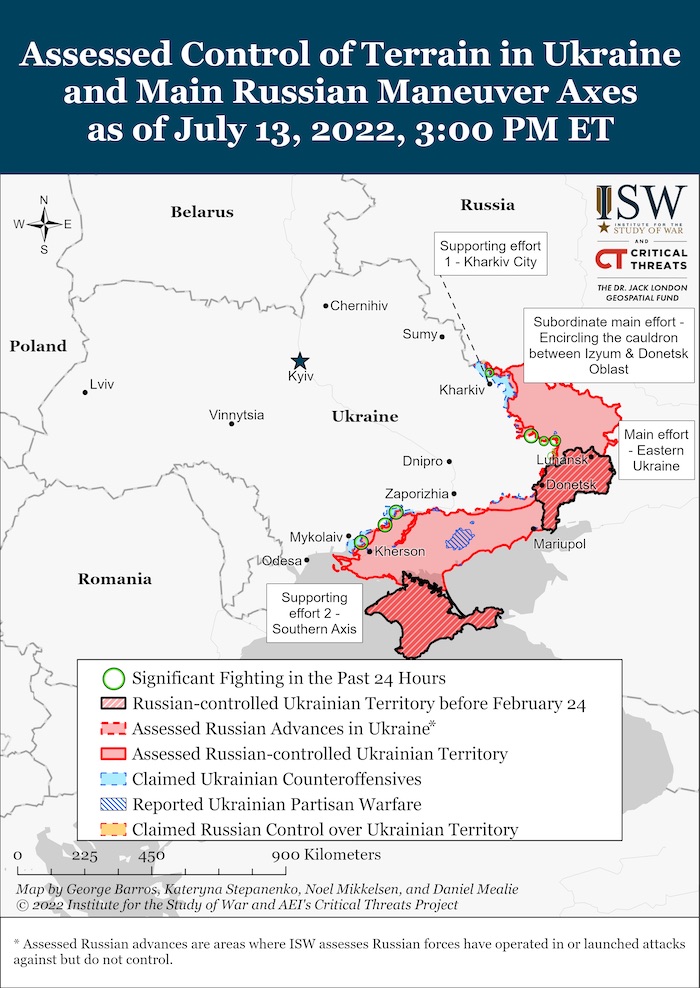
According to information from the General Staff as of 06.00 14.07.2022, supplemented by its [18:00 assessment].
Quote. “There are no changes in the composition, the position of units and the nature of Russian forces' activity in the Volyn, Polissya and Siversky directions.
Russian forces shelled the Doroshivka and Hrabovske areas of the Sumy oblast with mortars and multiple rocket launchers. [In the Siversky direction, Russian forces are taking measures to strengthen the counter-intelligence regime in the border areas of the Kursk region. The areas of the settlements of Vovkivka, Volfyne and Pokrovka of the Sumy oblast were shelled with mortars. Also, in Sumy oblast, it conducted aerial reconnaissance by UAVs near Zarutsky, Shalygyne and Starykove.]
[In the Slobozhansky direction:]
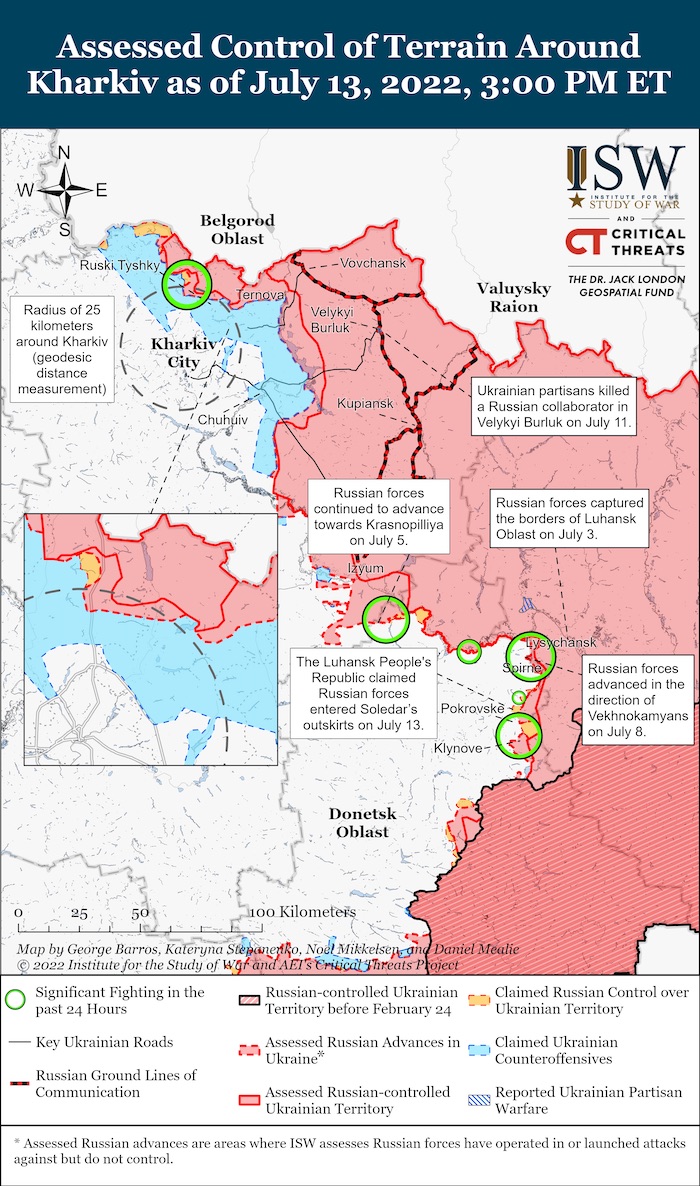
- [In the Kharkiv direction, the occupiers are concentrating their main efforts on preventing the advance of our troops.] Russian forces fired artillery of various calibres in the areas of Derhachi, Cherkaska Lozova, Dementiivka, Ruski Tyshki, Cherkaski Tyshki and Slatyne settlements. [Yesterday, Russian occupiers shelled the areas of the settlements of Kharkiv, Dementiiivka, Ruski and Cherkassy Tyshki, Slatyne, Prudyanka, Zalyman, Stary Saltiv, Petrivka, Ruska Lozova, Udy, Yavirske, Korobochkyne and Peremoha. A pair of Ka-52 helicopters struck near Verkhnyi Saltov and Petrivka.]
- [Once again, Ukrainian soldiers repelled an enemy assault in the direction of Dementiivka. Currently, Russian forces are restocking supplies and trying to replenish units that have suffered losses of personnel and military equipment.]
- In the Sloviansk direction, Russian forces are carrying out fire damage near Barvinkove, Dibrivne, Kurulka, Podolivka, Chepil, Krasnopilla, and Bohorodychny. Russian forces tried to conduct an assault in the direction of Kurulka, but were unsuccessful and retreated. [Yesterday, they shelled the areas of Tetyanivka, Donetske, Raihorodok, Dolyna, Dibrivne, Kurulka, Mazanivka, Virnopillya, Husarivka, Chepil, Velyka Komyshuvakha, Krasnopillya and others with artillery and MLRS. Conducted an airstrike near Mazanivka.]
- [Our defenders successfully repelled the assaults in the directions of Ivanivka and Dolyna and drove the invaders back.]
[In the Donetsk direction:]
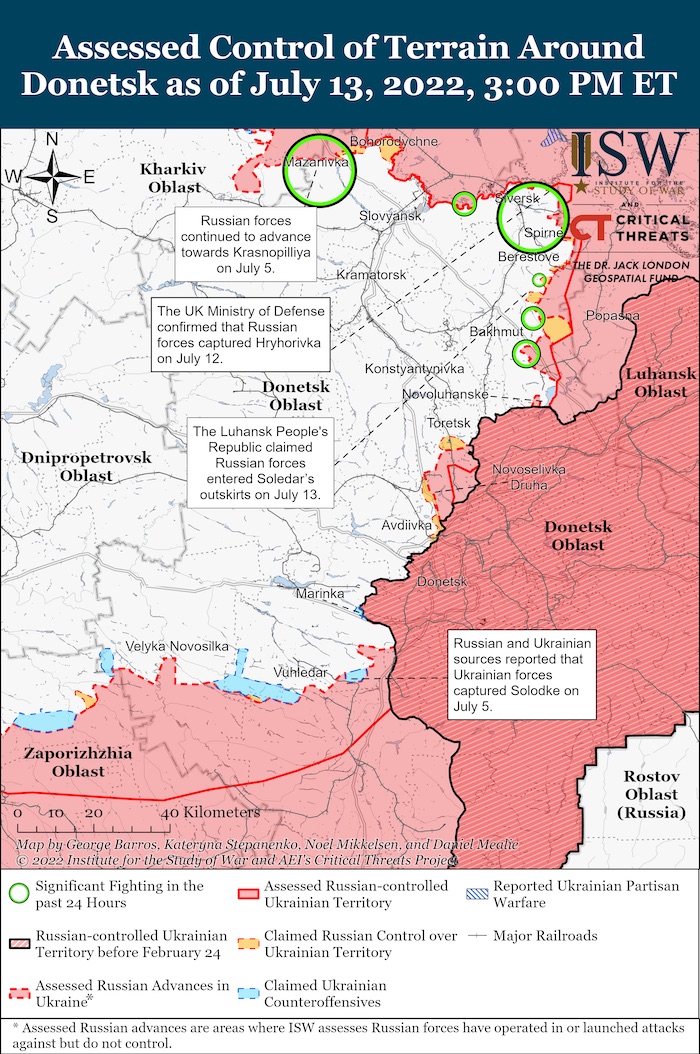
- In the Kramatorsk direction, Russian forces shelled the Hryhorivka, Siversk, Kramatorsk, Verkhnokamyansk, Zakitne, Serebryanka, and Spirne districts with artillery and MLRS. Carried out airstrikes near Verkhnyokamyanske and Mayaki. It is conducting an offensive in the direction of Verkhnokamyanske, and hostilities continue. [Yesteday, Russian forces shelled the areas of Mykolaivka, Kryvya Luka, Siversk, Serebryanka, Verkhnyokamyanske and Ivano-Daryivka with barrel artillery and mortars. Airstrikes were recorded near Spirne.]
- In the Bakhmut direction, Russian forces fired from tanks, artillery and MLRS in the areas of settlements of Novoluhanske, New York, Pokrovske, Vesela Dolyna, Soledar, Berestove, Vesele, Vyimka, Semyhirya, Vershina and near the Vuhlehirskaya TPP. It carried out airstrikes near New York, Ivano-Daryivka and Semyhirya. Ukrainian soldiers repelled assaults in the direction of Kodema and Vershyna. [Yesterday, the occupiers fired from artillery and MLRS in the areas of the settlements of Vyimka, Berestov, Bilohorivka, Soledar, Bakhmutske, Pokrovske, Bakhmut, Opytne, Vesela Dolyna, Vershyna, Travneve, Vuhlehirska TPP, Kodema, Toretsk, Shumy, Mayorsk and Zaitseve. An airstrike was carried out near Vershyna.]
- [All attempts of enemy assaults in the direction of Vesela Dolyna, Yakovlivka and Vershyna were nullified by our soldiers with accurate fire. The occupiers, with losses, withdrew. Russian forces also failed reconnaissance by combat in the Pokrovsk]
- Russian forces did not conduct active operations in the Kurakhivka, Novopavlivka, and Zaporizhzhia directions. Shelling was recorded near Novomykhailivka, Shakhtarske, Velyka Novosilka, Pavlivka, Novoukrainka, Vremivka, Zaliznychne, Olhivske, Temyrivka, Hulyaipilske, Malynivka, Hulyaipole, Kamianske, Mali Shcherbaky, Novoandriivka and Kamianka. Russian forces carried out airstrikes near Avdiivka and Kamyanka. It carried out an offensive in the direction of the settlement of Kamyanka, with partial success. [Yesterday, Russian forces continued shelling from artillery and MLRS along the contact line, albeit with less intensity. He also carried out airstrikes in the vicinity of Maly Shcherbaky, Mala Tokmachka, Kamianske and Novomykhailivka. Conducted aerial reconnaissance of the UAVs near Novoprokopivka and Mala Tokmachka.]
In the Pivdenny Buh directions, Russian forces are concentrating their efforts on preventing the offensive of units of the Defense Forces of Ukraine. [The Russian forces fired from tanks, artillery znd MLRS in the areas of the settlements of Potyomkyne, Knyazivka, Osokorivka, Dobryanka, Bila Krynytsya, Partizanske, Blahodatne, Kyselivka, Novohryhorivka, Zorya, Olenivka, Kotlyareve, Shevchenkove, Luch, Posad-Pokrovske , Stepova Dolyna, Ukrainka, Prybuzke, Nova Zorya, Lymany and Lupareve. Russian forces also carried out aerial reconnaissance by UAVs.]
[In the waters of the Black Sea and the Sea of Azov, the Black Sea Fleet is keeping four warships with high-precision weapons in readiness for launching missile strikes against objects on the territory of Ukraine.]
There are recorded cases of unsatisfactory food supply of the occupying troops. According to the available information, the staffing level of platoon commanders in the units of the 2nd Combined Arms Army of the Central Military District remains low. The reason is significant losses and refusal to participate in hostilities on the territory of Ukraine.
[In some places, Russian losses exceed the manpower indicators, which significantly affects the general morale and psychological state and becomes a prerequisite for the refusal of personnel to further participate in hostilities against Ukraine. It has come to the point where the Russian command uses physical violence against subordinates.]”
Military Updates
Ukraine destroyed 5 Russian ammunition depots on 13 July - Odesa RegAdm. Spox
❌Luhansk
❌Chornobayivka, Kherson Oblast
❌Makiiivka, Donetsk Oblast
❌Chaplinka (district), Kherson Oblast
❌Horlivka, Donetsk Oblasthttps://t.co/zwmgBuIpwd— Euromaidan Press (@EuromaidanPress) July 13, 2022
Russian soldiers deserting due to Ukrainian artillery fire, Ukrainska Pravda reports, citing the Zaporizhzhia Oblast Military Administration on Telegram. "According to information from Ukrainian intelligence, units of the FSB of Russia are searching for deserters from the occupying forces on the territory of the temporarily occupied Zaporizhzhia Oblast. The number of soldiers who have left their units due to the threat of artillery strikes from the Armed Forces of Ukraine is increasing every day and is currently about 60 people.”
Strike aviation has already carried out 1,700 group strikes against Russian forces — Ukrainian Air Force, Ukrainska Pravda reports, citing Yurii Ihnat, Air Force Command spokesman. "A total of 1,700 group airstrikes have been carried out by [Ukrainian - ed.] strike aircraft against the positions, warehouses, equipment and manpower of the Russian occupying forces on the front lines since the beginning of Russia’s full-scale invasion. Ihnat said that Su-25 attack aircraft and Su-24M bombers, with the support of Army helicopters, were continuing to provide air support to ground troops in the southern and eastern regions of Ukraine, despite the large number of Russian air defences that the occupiers have concentrated in the temporarily occupied territories.”
Explosions are heard in Nova Kakhovka (Russian-occupied, ~60km from the frontline), local TG channels reported.
Two days ago, a massive detonation happened here after an ammunition depot was hit by a Ukrainian missile. https://t.co/06cMzVhgIa pic.twitter.com/Er9loM8RWp
— Euromaidan Press (@EuromaidanPress) July 13, 2022
According to British Defence Intelligence, (last 48 hours):
- In the Donbas, Russian forces continue to conduct artillery strikes across a broad front followed by, in some areas, probing assaults by small company and platoon-sized units. However, they have achieved no significant territorial advances over the last 72 hours and are in danger of losing any momentum built up following the capture of Lysychansk.
- The ageing vehicles, weapons, and Soviet-era tactics used by Russian forces do not lend themselves to quickly regaining or building momentum unless used in overwhelming mass – which Russia is currently unable to bring to bear.
- Despite 13 July 2022 talks between delegations from Ukraine, Russia, Türkiye, and the UN on grain exports and recent successfully negotiated prisoner exchanges, the prospects for wider talks to end the conflict remain low.
- In the Donbas, Russian forces will likely focus on taking several small towns during the coming week, including Siversk and Dolyna on the approaches to Sloviansk and Kramatorsk. The urban areas of Sloviansk and Kramatorsk likely remain the principal objectives for this phase of the operation.
- Russia continues to seek to undermine the legitimacy of the Ukrainian state and consolidate its own governance and administrative control over occupied parts of Ukraine. Recently this has included an initiative to twin Russian and Ukrainian cities and regions to develop post-conflict administrations and a decree to make it easier for Ukrainians to obtain Russian citizenship.
- Anti-Russian sentiment in occupied Ukraine is leading to Russian and pro-Russian officials being targeted. The Russian-appointed administration in Velykyy Burluk acknowledged that one of its mayors was killed on 11 July 2022 by a car bombing. The targeting of officials is likely to escalate, exacerbating the already significant challenges facing the Russian occupiers and potentially increasing the pressure on already reduced military and security formations.
Losses of the Russian army
As of Thursday 14 July, the approximate losses of weapons and military equipment of the Russian Armed Forces from the beginning of the war to the present day:
- Personnel – more than 37870 (+300),
- Tanks – 1667 (+18),
- Armoured combat vehicles – 3852 (+20),
- Artillery systems – 840 (+1),
- Multiple rocket launchers –MLRS - 247 (+0),
- Air defence means – 109 (+0),
- Aircraft - 219 (+2),
- Helicopters - 188 (+0),
- Automotive technology and fuel tanks – 2720 (+16),
- Vessels/boats - 15 (+0),
- UAV operational and tactical level – 681 (+3),
- Special equipment – 67 (+0),
- Mobile SRBM system – 4 (+0),
- Cruise missiles – 155 (+0)
Russian enemy suffered the greatest losses (of the last day) in the Kramatorsk direction.
⚰️russia's combat losses in Ukraine as of July 14
▪ 37870 killed soldiers (+300)
▪ 3852 APV (+20)
▪ 1667 tanks (+18)
▪ 840 artillery systems (+1)
▪ 219 aircraft (+2) and 188 helicopters
▪ 15 boats and cutters #StopRussia #StandwithUkraine pic.twitter.com/y14CrLKehJ— VoxUkraine (@voxukraine) July 14, 2022
Humanitarian
The US calls for an immediate halt to Russian deportations in Ukraine, Reuters reports. “The United States called on Russia to immediately release Ukrainians it has forced out of their home country and allow outside observers, citing reports Moscow was putting Ukrainian children up for adoption and "disappearing" thousands of others.
"The unlawful transfer and deportation of protected persons is a grave breach of the Fourth Geneva Convention on the protection of civilians and is a war crime," US Secretary of State Antony Blinken said on Wednesday.
In a statement, Blinken said reports indicated Moscow was "deliberately separating Ukrainian children from their parents and abducting others from orphanages before putting them up for adoption inside Russia", and also "detaining or disappearing thousands of Ukrainian civilians who do not pass 'filtration.'"
Ukrainian officials have accused Russia of deporting hundred of thousands of people from Russian-occupied areas of Ukraine and forcing them into so-called "filtration camps", and called for support from the Red Cross.”
https://twitter.com/EuromaidanPress/status/1547255784500862979
Two-thirds of Ukraine refugees plan to stay put for now – UN, Reuters reports. “Around two-thirds of refugees from Ukraine expect to stay in their host countries until hostilities subside and the security situation improves after Russia's invasion, a survey by the United Nations refugee agency UNHCR has found.
Most of the refugees from Ukraine, mainly women and children, hope to return home eventually, according to the survey of around 4,900 people from Ukraine now living in the Czech Republic, Hungary, Moldova, Poland, Romania and Slovakia. The survey was conducted between mid-May and mid-June.
UNHCR says more than 5.6 million refugees are now recorded across Europe, with nearly 8.8 million people crossing out of Ukraine and nearly 3.3 million crossing back in since the Russian invasion on Feb. 24.”
Russia Repeatedly Strikes Ukraine’s Civilians. There’s Always an Excuse, The New York Times reported on 11 July. The Kremlin’s explanations have sometimes satisfied the Russian people, but they fall apart under closer scrutiny abroad. Since late February, when Russia began pummeling Ukraine with missiles and artillery on a scale unseen in Europe for decades, civilian deaths have been as inevitable as the Russian excuses that follow.
Russia has claimed that it aims only at targets of military value — even though some were hundreds of miles from the front lines — and that whenever a civilian facility did get hit, it was one that the Ukrainian military had co-opted for use as a command post, a shelter for foreign fighters or storage for weapons.
The Kremlin mantras have found resonance among the Russian people, many of whom are influenced by state-controlled television networks and conservative pro-war online commentators who bolster the party lines.
Yet journalists, independent organizations and Ukrainian officials have documented Russian attacks on thousands of civilian buildings, structures and vehicles. In some cases, Russia used outdated weapons that might have been aimed at an industrial facility but missed, putting civilians at risk. But in many other cases, the Russians’ explanations have not held up under scrutiny.
The article lists a few of the largest attacks, along with how Russia has explained away responsibility:
- July 9: Apartment complex in Chasiv Yar. At least 47 people were killed after Russian rockets slammed into an apartment complex.
- July 1: Hotel and residential tower near Odesa, killing at least 21 and injured dozens of others.
- June 27: Kremenchuk shopping mall. A daytime attack on a busy shopping mall killed 21 and injured 65 in Kremenchuk, in central Ukraine.
- April 8: Kramatorsk train station. A rocket attack on a crowded train station that was packed with civilians trying to escape to safer areas killed at least 59 people and wounded many more.
- March 16: Mariupol theatre. AP evidence points to 600 dead in an attack on a theatre that people had been using as a bomb shelter, local officials said. The word “children” was written in Russian in large white letters on the ground in front of and behind the building.
- March 16: Chernihiv bread line. At least 18 people were killed and 26 were injured when a munition struck a bread line outside a supermarket in Chernihiv, according to Human Rights Watch.
- March 3-30: Bucha executions. The bodies of dozens of people, many of whom had apparently been executed, were found scattered across the Kyiv suburb after Russian forces withdrew at the end of March. 412 bodies had been found in the town’s streets, buildings and mass graves as of April 19.
Millions of refugees from Ukraine have crossed borders into neighboring countries, and many more have been forced to move inside the country. The escalation of conflict in Ukraine has caused civilian casualties and destruction of civilian infrastructure, forcing people to flee their homes seeking safety, protection, and assistance the UNHCR reports. As of 13 July:
Individual refugees from Ukraine recorded across Europe: 5,816,729
- Belarus, Hungary, Republic of Moldova, Poland, Romania, Russian Federation, Slovakia 3,134,486
- Other European countries 2,682,243
Refugees from Ukraine registered for Temporary Protection or similar
national protection schemes in Europe: 3,654,271
- Hungary, Poland, Romania, Slovakia 1,374,868
- Other European countries 2,279,403
Border crossings from Ukraine (since 24 February 2022): 9,152,696
Border crossings to Ukraine (since 28 February 2022): 3,546,305
OHCHR recorded 11,544 civilian casualties in Ukraine as of July 11. 5,024 were killed (including 343 children) and 6,520 injured (including 533 children).
️️Environmental
EU lawmakers seek more energy savings to tackle the gas crunch, Reuters reports. “Lawmakers on the European Parliament's energy committee supported more ambitious EU targets to save energy and expand renewable power on Wednesday, viewed as key to ending Europe's reliance on Russian gas.
Brussels is scrambling to prepare for further cuts to Russian gas supplies and will unveil a plan next week for how countries could cope this winter if Moscow halted deliveries.
Meanwhile, the EU is negotiating more ambitious laws to push countries to replace Russian gas with clean energy this decade and reduce planet-warming CO2 emissions. The Parliament's energy committee backed a proposal on Wednesday to raise the EU's target for primary and final energy savings to 14.5% by 2030 compared with expected levels, and set binding contributions for every country.”
https://twitter.com/EuromaidanPress/status/1547301863346671616
Shipment of Ukrainian grain: Special coordination center to be set up in Istanbul, Ukrinform reports. “Following the meeting [Wednesday], […] an agreement has been reached on basic technical issues, such as the establishment of a coordination centre in Istanbul, where representatives of all sides will be present, joint controls at entry and exit of ports, as well ensuring navigational safety on transfer routes, the Turkish Defence Minister Hulusi Akar said.”
Hans Petter Midttun: The Turkish Defence Minister announced another meeting in Türkiye next week to review the details of the agreement and sign relevant documents. This indicates that the agreement reached yesterday is pending confirmation in Moscow and Kyiv. Türkiye has several times issued statements that have later been refuted by Ukraine.
Sixteen vessels sail through Bystre Canal to be loaded with Ukrainian grain, Ukrinform reports, citing the Ukrainian Infrastructure Ministry on Facebook. “Over the past four days, a total of 16 vessels have sailed through the Bystre Canal. We are planning to keep up the pace. The restoration of navigation through this canal is an important step, which will also allow us to unload the Sulina branch and speed up grain exports. Unfortunately, at the moment the canal’s waterway capacity and organization of work allow us to receive only four vessels, while we need at least eight vessels per day,” Ukrainian Infrastructure Deputy Minister Yurii Vaskov told.
In his words, the Ukrainian Infrastructure Ministry is holding talks with Romanian counterparts and the representatives of the European Commission to increase the number of vessel calls through the Sulina branch.
According to the ministry, due to the blockade of Ukrainian sea ports, which used to handle about 80% of Ukraine’s agricultural exports before the Russian invasion started, food products are now exported from Ukraine via the Danube ports, railway and road checkpoints at the western borders. Their capacity is not enough to fully replace the seaports. In June 2022, about 2.5 million tonnes of agricultural products were exported via the available logistic routes. Meanwhile, the monthly demand for such exports is 8 million tonnes.”
In a week, traffic jams near the Danube Delta of vessels for grain export will disappear - the ministry, Ukrainska Pravda reports. “More than 90 ships are currently waiting for their turn to enter the Ukrainian ports at the Sulina Canal. A total of 135 vessels are on the roadway of the Romanian Sulina Canal.
As the Deputy Minister of Infrastructure Yuriy Vaskov said, currently the capacity and organisation of work at Sulin make it possible to receive only 4 ships, if necessary, at least 8 ships per day. However, the government is negotiating with Romanian colleagues and representatives of the European Commission to increase the number of crossings through the Sulin channel.
"Under these conditions and the availability of a route through the mouth of Bystre, we expect that within a week the congestion of ships on the route will be eliminated and we will be able to increase the monthly export of grain by 500 thousand tons," Vaskov said.
In addition, at the request of the Ministry of Infrastructure of Ukraine, the Naval Forces of the Armed Forces of Ukraine joined the organisation of transportation by civilian ships.”
https://twitter.com/EuromaidanPress/status/1547311030136627201
Legal
Zelensky: Russians deport 2M Ukrainians, tens of thousands remain in filtration camps, Ukrinform reports. Russia has forcibly removed from Ukraine nearly 2 million people, including several hundred thousand children, while tens of thousands of Ukrainians are being held in filtration camps in the temporarily occupied territories, President Zelensky told in a video address to the Asian Leadership Conference in Seoul.
"Just imagine this number – two million people. That’s how many of our people have already been taken to Russia. Several hundred thousand children… No one will name the exact numbers at the moment – all these deported people are deprived of means of communication, their IDs have been taken from them, and they are being intimidated and taken to remote areas of Russia so that it will be as difficult as possible for them to return home to their Motherland, the president noted.
He also emphasized that Russia created in the occupied territory the so-called filtration camps, through which it forces Ukrainians to pass. According to Zelensky, tens of thousands remain in those camps. Young women disappear there. I believe you all understand what’s happening to them there, the head of state added.”
Russia’s “Filtration” Operations, Forced Disappearances, and Mass Deportations of Ukrainian Citizens, a press statement from the US Department of State reads.
“The United States calls on Russia to immediately halt its systematic “filtration” operations and forced deportations in Russian-controlled and held areas of Ukraine. The unlawful transfer and deportation of protected persons is a grave breach of the Fourth Geneva Convention on the protection of civilians and is a war crime. Russian authorities must release those detained and allow Ukrainian citizens forcibly removed or coerced into leaving their country the ability to promptly and safely return home. We call on Russia to provide outside independent observers access to so-called “filtration” facilities and to forced deportation relocation areas in Russia.
Estimates from a variety of sources, including the Russian government, indicate that Russian authorities have interrogated, detained, and forcibly deported between 900,000 and 1.6 million Ukrainian citizens, including 260,000 children, from their homes to Russia – often to isolated regions in the Far East. Moscow’s actions appear pre-meditated and draw immediate historical comparisons to Russian “filtration” operations in Chechnya and other areas. President Putin’s “filtration” operations are separating families, confiscating Ukrainian passports, and issuing Russian passports in an apparent effort to change the demographic makeup of parts of Ukraine.
Reports also indicate that Russian authorities are deliberately separating Ukrainian children from their parents and abducting others from orphanages before putting them up for adoption inside Russia. Eyewitnesses and survivors of “filtration” operations, detentions, and forced deportations report frequent threats, harassment, and incidents of torture by Russian security forces. […]
Evidence is mounting that Russian authorities are also reportedly detaining or disappearing thousands of Ukrainian civilians who do not pass “filtration.” Those detained or “filtered out” include Ukrainians deemed threatening because of their potential affiliation with the Ukrainian army, territorial defense forces, media, government, and civil society groups. Eyewitnesses, survivors, and Ukraine’s General Prosecutor have reported that Russian authorities have transported tens of thousands of people to detention facilities inside Russian-controlled Donetsk, where many are reportedly tortured. There are reports that some individuals targeted for “filtration” have been summarily executed, consistent with evidence of Russian atrocities committed in Bucha, Mariupol, and other locations in Ukraine.”
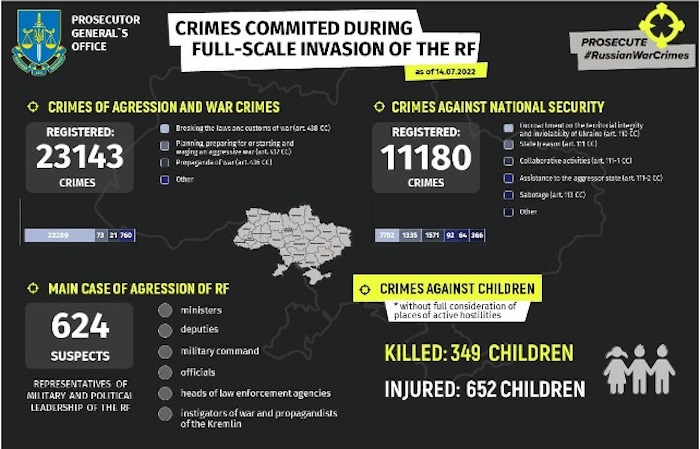
349 children were killed, and 652 children injured, the Office of the Prosecutor General of Ukraine reports as of July 14. 2,126 educational establishments are damaged as a result of shelling and bombings, 216 of them are destroyed fully. 23,143 crimes of aggression and war crimes and 11,180 crimes against national security were registered.
#CrimeanTatar #journalist detained on charges of ‘discrediting #Russia army’ and jailed for 'showing resistance' in occupied #Crimea #LetMyPeopleGo #Ukraine #StandWithUkraine #StopRussiahttps://t.co/0el5aQmz7y pic.twitter.com/uxypEEZqB0
— Halya Coynash (@halyapuff) July 13, 2022
Support
Germany reveals the list of weapons given to Ukraine, Ukrinform reports. “The German government has published a complete list of weapons systems, equipment, and other lethal and non-lethal military support delivered to Ukraine, as it is resisting Russia's armed aggression. In 2022 Germany has increased its funds for security capacity building to 2 billion Euros. These additional funds are primarily dedicated to Ukraine as well as German contributions to the European Peace Facility, from which cost of military support measures for Ukraine can be reimbursed to EU member states," the report said.
The planned deliveries of weapons and equipment include M113 armoured personnel carriers, GEPARD self-propelled anti-aircraft guns, COBRA counter-battery radar systems, MARS multiple rocket launchers, and other systems.”
Senate Intelligence Committee chief: Accelerated Russian aggression will only strengthen US support for Ukraine, Ukrinform reports, citing Guildhall. “The violent actions and rhetoric that we have seen from Vladimir Putin in recent months represent the latest in a long string of offensive actions by the Russian President. Accelerated Russian aggression will only strengthen US assistance for our Ukrainian partners, and reinvigorate NATO’s collective defence posture, US Senator Mark Warner, who chairs the Intelligence Committee, said. The senator also noted he would continue engaging in efforts to assist Ukraine on security, intelligence, and diplomacy.”
Foreign funds cover only half of Ukraine’s budget deficit, Ukraine Business News reports. “According to the Ukraine Ministry of Finance, funds from the international community in March-June covered only half of Ukraine’s budget needs of $22B. Out of the $22B needed to cover the budget deficit and repay debts in March-June, Ukraine received only $10.2B in foreign loans and grants.
At the same time, the dynamics of these receipts allow Ukraine to count on at least a partial covering of its deficit due to international aid during the year’s second half. For example, considering the funds received at the beginning of July, budget receipts from February 24 to July 5 exceeded $11B. Since the war, Ukraine’s partners have pledged to provide loans and grants worth $32B.”
Ukraine may receive $4.4B in aid in July - Ministry of Finance, Ukrinform reports. The Ministry of Finance expects Ukraine to receive about $4.4 billion in aid from international partners in July, according to Minister of Finance, Serhii Marchenko.
“This month, we expect $4.4 billion. Last month, we received $4.4 billion. In May, the situation was not so optimistic, as we received only $1.5 billion, Marchenko said. He noted that the government is making every effort to ensure that monthly receipts from foreign partners exceed $4 billion. This will allow us to support the hryvnia and make all the necessary payments, the minister said.
Ukrainian Prime Minister Denys Shmyhal earlier said that by the end of the year, Ukraine will receive another $20 billion in aid and support from international partners.”
New Developments
https://twitter.com/EuromaidanPress/status/1547269503280619522
- No talks are ongoing with Russia on ending the war – Kuleba, Ukrinform "Currently, there are no negotiations between Russia and Ukraine because of Russia's position and its continued aggression toward our country. So there is nothing to discuss, said the Minister for Foreign Affairs of Ukraine, Dmytro Kuleba. Kuleba recalled that Ukraine's goal in the war that Russia unleashed against its neighbour is to liberate own territories and restore its territorial integrity and full sovereignty in the east and south of the country.”
- Ukraine rules out ceding territory to Russia to secure peace, Reuters “Ukrainian Foreign Minister Dmytro Kuleba on Wednesday ruled out ceding territory to Russia as part of any peace deal and said no peace talks were underway between Moscow and Kyiv. The objective of Ukraine in this war... is to liberate our territories, restore our territorial integrity, and full sovereignty in the east and south of Ukraine, he told a briefing. This is the end point of our negotiating position."
- Lukashenka claims that NATO is preparing to attack Russia "via Ukraine and Belarus", Ukrainska Pravda reports, citing the Pul PervogoTelegram channel. “Aliaksandr Lukashenka, the self-proclaimed President of Belarus, has once again claimed that NATO intends to attack Russia "via Ukraine and via Belarus. Lukashenka has repeatedly claimed that Ukraine is prepared to attack both Russia and Belarus.”
- Lithuania will allow sanctioned Russian goods trade to Kaliningrad, Reuters “European Union member Lithuania will allow sanctioned Russian goods to transit its territory on their way to Russia's Kaliningrad exclave, its Foreign Ministry said on Wednesday, reversing its policy after new European Commission guidelines. The new guidelines on Wednesday followed weeks of tension among Moscow, Lithuania and the European Union that tested Europe's resolve to enforce sanctions on Russia.”
- Breakthrough at Ukraine grain export talks as heavy shelling continue, Reuters “Ukraine, the United Nations and Türkiye hailed progress at talks aiming to resume Black Sea grain exports blocked by Russia and ease the risk of starvation faced by millions, but an end to the war remained far off as heavy shelling continued on Thursday. Türkiye's Defence Minister Hulusi Akar said on Wednesday an agreement would be signed next week. Ankara will ensure the safety of shipments in transit and the parties will jointly check grain cargoes in ports, he added. But UN chief Antonio Guterres said more work was needed before a deal was finalised.”
- Germany expects direct but difficult dialogue with Russia at G20 - govt sources, Reuters “Germany is expecting more open and direct discussions with Russia at the upcoming meeting of finance ministers from the Group of 20 nations, government sources said on Wednesday, after a G20 meeting in April was disrupted by walkouts. Most will want to adopt a different approach on the day after April, one of the sources added, referring to a walkout staged by top officials from Britain, the United States and Canada.”
- The US fears that without controls on the price of oil, it will increase by 40%, Ukraine Business News “The global oil price could rise by 40% to around $140 per barrel if the proposed cap on the price of Russian oil is not passed, said the US Treasury Department. US Treasury Secretary Janet Yellen will discuss the implementation of the price cap proposal and the development of the global economy with Japanese Finance Minister Shunichi Suzuki on Tuesday. The purpose of the proposed instrument is to set the price at a level that would cover only Russia’s marginal costs of oil production so that the Russian Federation would have an incentive to continue exporting oil but not so high as to allow it to finance its war against Ukraine.”
"Our goal should not be averting a Ukrainian defeat. It should be enabling a Ukrainian victory. That’s the only way to shorten the war and end the suffering," Max Boot writes, claiming the West has not yet set clear goals of its military aid for Ukraine.https://t.co/2mUXHKEvCL
— Euromaidan Press (@EuromaidanPress) July 14, 2022
Assessment
- On the war.
map source: https://www.understandingwar.org/backgrounder/russia-offensive-campaign-assessment-july-13*
The Institute for the Study of War has made the following assessment as of Saturday 13 July, 2022:
The Institute for the Study of War has made the following assessment as of Wednesday 13 July:
“The Kremlin likely ordered Russian “federal subjects” (regions) to form volunteer battalions to participate in the Russian invasion of Ukraine, instead of declaring partial or full mobilization in Russia. Russian war correspondent and milblogger Maksim Fomin stated that Russia has begun a “volunteer mobilization,” where every region must generate at least one volunteer battalion. The term “volunteer mobilization” likely implies that the Kremlin ordered the 85 “federal subjects” (regions, including occupied Sevastopol and Crimea) to recruit and financially incentivize volunteers to form new battalions, rather than referring to literal mobilization relying on conscription or the compulsory activation of all reservists in Russia. Russian outlets reported that regional officials recruit men up to 50 years old (or 60 for separate military specialties) for six-month contracts and offer salaries averaging 220,000 to 350,000 rubles per month (approximately $3,750 to $6,000). Separate regions offer an immediate enlistment bonus that averages 200,000 rubles (approximately $3,400) issued from the region‘s budget and social benefits for the servicemen and their families. Russian media has already confirmed the creation or deployment of volunteer battalions in Kursk, Primorskyi Krai, Republic of Bashkortostan, Chuvashia Republic, Chechnya, Republic of Tatarstan, Moscow City, Perm, Nizhny Novgorod, and Orenburg Oblasts in late June and early July. Tyumen Oblast officials announced the formation of volunteer units (not specifically a battalion) on July 7.
Volunteer battalions could generate around 34,000 new servicemen by the end of August if each federal subject produces at least one military unit of 400 men. Some Russian reports and documentation suggest that the Kremlin seeks to recruit an estimated 400 soldiers per battalion, who will receive a month of training before deploying to Ukraine. The number of men may vary as some federal subjects such as Republic of Tatarstan and Chechnya are establishing two and four volunteer battalions, respectively. It is possible that some federal subjects may delay or not participate in the establishment of the battalions, with officials in Volgograd reportedly remaining silent on the formation of the new units. Newly formed battalions are currently departing to training grounds and will likely complete their month-long training by end of August but they will not be combat ready in such a short time period.
Russian milbloggers criticized the Russian military on July 12 for sourcing Iranian UAVs to improve artillery targeting in Ukraine while failing to address the command issues that more severely limit the effectiveness of Russian artillery. Russian Telegram channel Rybar claimed on July 12 that Russian requests and approval for artillery fire pass through a convoluted chain of command, resulting in a delay of several hours to several days between Russian ground forces requesting artillery fire, Russian targeting, and conducting the actual strikes. Rybar claimed that Russian forces in Syria reduced the time between targeting and striking to under an hour. Rybar claimed that while the Russian need for more UAVs is clear and that Iranian UAVs helped achieve a target-to-fire time of 40 minutes in Syrian training grounds additional UAVs do not solve the problems of overcentralized Russian command and overreliance on artillery in Ukraine. Russian milblogger Voyennyi Osvedomitel’ claimed that Russian forces had faced the same overcentralized command during the First Chechen War, wherein the inability of Russian ground forces to request artillery support without going through a chain of command inhibited responses to enemy offensive actions. Milblogger Yuzhnyi Veter claimed that Ukrainian artillery forces’ target-to-response time is under 40 seconds.
Key Takeaways
- The Kremlin likely ordered Russian “federal subjects” (regions) to form volunteer battalions to deploy to Ukraine.
- Russian forces conducted failed ground assaults north of Sloviansk and around Bakhmut.
- Russian forces continued air and artillery strikes around Siversk and west of Donetsk City.
- Russian forces continued targeting Ukrainian rail lines on the Eastern Axis.
- Russian forces attempted limited and unsuccessful ground assaults north of Kharkiv City.
- Russian forces prioritized defensive operations on the Southern Axis as Ukrainian forces continued targeting ammunition depots.
- Russian occupation authorities are increasing financial incentives for civilians working in occupied Ukraine.
Russian occupation authorities may be setting conditions to forcibly relocate Ukrainian children in occupied territories to Crimea.“
Ukrainian forces continued to strike Russian ammunition depots in southern Ukraine on July 11 and July 12, IWS reports. The Ukrainian Southern Operational Command confirmed that Ukrainian forces destroyed ammunition depots in Nova Khakovka and Charivne, approximately 60 km east and 65 km northeast of Kherson City. Russian-appointed officials and pro-Kremlin outlets claimed that Ukrainian forces targeted civilians and killed seven residents, but Ukrainian Strategic Command denied those claims. Social media users from Terpinnya, Myrne, and Semenivka (just north of Melitopol) also observed approximately 25 explosions, with unconfirmed reports of fires in the area of the local Ministry of Emergency Situations building where Russian forces assembled a military base.
Russian and Ukrainian sources reported that Ukrainian strikes on a Russian base in Kherson City on July 10 killed 20th Guards Motorized Rifle Division Commander Colonel Aleksei Gorobets, 20th Guards Motorized Rifle Division Deputy Commander Colonel Sergey Kens, and 20th Guards Motorized Rifle Division Deputy Artillery Commander Lieutenant Colonel Alexander Gordeev. Ukrainian sources reported the strikes also killed 22nd Army Corps Chief of Staff Major General Artyom Nasbulin, though Russian sources have not confirmed that loss as of this publication. The Ukrainian Main Military Intelligence Directorate (GUR) intercepted a call in which a Russian serviceman claimed that a Ukrainian strike on the main Russian command post in Kherson Oblast killed 12 servicemen but did not specify the location of the command post.
The Arms Race. Ukraine and Russia are racing to replenish their depleted stocks of weapons, The New York Times reports. With Russia making slow but steady gains in the east, Ukraine has increasingly appealed for faster deliveries of sophisticated weapons from the West to hold off its better-armed foe.
The US and many European countries have promised more weaponry, but they are wary of sending too much before Ukrainian troops can receive proper training. The Pentagon is also concerned about potentially depleting its own stockpiles.
Many of Russia’s precision-guided weapons have been used up in nearly five months of bombardment, and Russia is now seeking hundreds of surveillance drones from Iran, according to President Biden’s national security adviser.
To get a sense of how the two sides are trying to replenish their military stocks, I spoke to Alexandra Marksteiner, a researcher at the Stockholm International Peace Research Institute who tracks the global arms industry. Our conversation has been lightly edited and condensed.
Will the arms industry be able to keep up with demand?
Alexandra: Right now it does seem like Ukraine is going through these stockpiles faster than can be replenished. Lockheed Martin produces about 2,100 Javelin missiles a year and Ukraine uses about 500 a day. Lockheed has promised to double production to 4,000, but that’s not going to be much of a dent.
Having the industrial capacity to replenish these stocks is going to be essential. This industrial capacity is what gave the Allies a leg up against the Axis powers during World War II. So it’s incredibly important. It’s an aspect of this war that’s not talked about enough.
The arms industry, even before the invasion, dealt with things that all other industries are dealing with at the moment — rising prices of inputs, labor shortages, supply chain issues. So there were already structural issues that were affecting it and now you have this massive increase in demand. […]
What is the situation in the West?
In Europe and the US, obviously if you take all those arms industries together, it’s going to be much larger than the arms industrial capacity of Russia. […] The strategic rivalry with China is taking up a lot of not just capacity, but mental head space in US defense planning. So you can’t say that the entire arms industry is going to be devoted to making the systems that are needed by Ukraine.
It’s also a matter of how quickly production capacities can be shifted. In the past couple of years, you had this idea that the future of war was going to be hybrid, it was going to be low intensity, more unconventional. So there was a focus on all these high tech, next generation technologies, artificial intelligence, hypersonic missiles. And then the Ukraine war kind of shot that impression completely. There is now renewed focus on traditional defense equipment: tanks, artillery, ammunition.
The focus has shifted and that means that production capacities are also going to have to shift in an industry that was already kind of struggling. […]
Russian media obtains the Kremlin’s closed survey on the war: 30% of all Russians and 50% of Russian youths are in favour of ending the war, Ukrainska Pravda reports, citing Meduza, which has received data of a closed poll of the WCIOM (All-Russian Centre for the Study of Public Opinion), organised by the Kremlin at the end of June
"The respondents were asked: ‘Some say that the hostilities in Ukraine should be stopped as soon as possible. Others believe that hostilities should not be stopped now. Which point of view is closest to your own – the first or the second?’ The number of Meduza respondents is unknown.
From the documents... It follows that 30% of people who answered this question believe that ‘hostilities in Ukraine’ should be ‘stopped as soon as possible’. Another 13% found it difficult to answer; 57% of respondents believe that the war should be continued."
Note that in the Russian survey, the war is still not called a war. The results of the survey also show that the younger generation is much more opposed to the continuation of the fighting than the older generation. According to the results of the same poll, in the age group 18-24 years, 56% are in favour of ending the war, and only 19% are in favour of continuing it. Among Russians aged 25–34, 43% support the end of the war, 41% the continuation of hostilities.”
2. Consequences and what to do?
Shorten the war. Send 60 HIMARS to Ukraine, Max Boot argues in an op-ed published in The Washington Post. “It has become commonplace to observe that Ukraine is mired in a “long war” — one that could last for years, according to NATO’s secretary general. That could well be correct. The war, after all, has already lasted nearly [8 years and five months – me] and continues to grind on. But I fear that by so readily accepting that there is no end in sight, we might be giving in to fatalism and defeatism. Instead of becoming resigned to a never-ending war, the West should be focusing on how to shorten the conflict by enabling Ukraine to win.
A long war, after all, probably favors Russia. Ukraine’s economy is set to shrink by 45 percent this year amid Russian attacks on economic infrastructure and a Russian blockade of the Black Sea coast. Russia is suffering from sanctions, but it is expected to take in more oil and gas revenue this year ($285 billion) than last year. While Russian dictator Vladimir Putin squelches domestic opposition, Western support for Ukraine could waver if Europeans have to endure sky-high prices for natural gas in the winter and if the increasingly isolationist Republicans take control of at least one house of Congress.
This is certainly no time for a “mission accomplished” moment — as if simply prolonging the war represents some kind of victory. It is dismaying to read in the New York Times that anonymous Biden administration officials are claiming the United States has already either accomplished or is about to accomplish its “strategic objectives” — ensuring that an independent Ukraine will survive, that the invasion will be a “strategic failure” for Russia, that there will be no “superpower conflict” and that the international order will be strengthened “around Western values.”
It is wildly premature to suggest that any of these objectives have been durably achieved; Putin hasn’t given up his evil scheme of enslaving Ukraine. It is also highly insensitive to tout supposed US success when roughly 20 percent of Ukraine remains under enemy occupation and more Ukrainians are being slaughtered every day. Would we be satisfied if an army of war criminals occupied 20 percent of the United States? By my calculation, that would include the entire states of California, Florida, Illinois, New York, Michigan and Texas. We wouldn’t live with such an outrage — and neither should the Ukrainians.
Fortunately, Ukraine has no shortage of volunteers willing to fight — and, if necessary, die — to defend their homeland. What Ukrainians lack are the weapons and training they need to roll back the Russian advance. They have been receiving some of both but not in the numbers needed.
The British army has undertaken a much-needed initiative to train 10,000 Ukrainians for military service. Other countries should set up their own programs so that the number of trained recruits can be increased exponentially to make up for wartime losses.
The United States and other countries have also been sending growing quantities of heavy weapons to Ukraine. The M142 High Mobility Artillery Rocket Systems (HIMARS) are proving particularly effective in allowing the Ukrainians to target Russian headquarters and ammunition depots. A Russian military blogger laments that Russian air defenses haven’t been able to stop HIMARS rockets, resulting in “BIG losses in personnel and equipment.”
Those are impressive results considering that Ukraine so far has received only nine HIMARS. The Biden administration just pledged four more in addition to nine others promised by allies. But Ukrainian officials are asking for many more HIMARS and would like to see them equipped with longer-range rockets. Michael G. Vickers, a former undersecretary of defense who helped mastermind the 1980s war against the Red Army in Afghanistan, recently suggested that Ukraine needs 60 to 100 HIMARS or other multiple-launch rocket systems to win the artillery duel.
Why aren’t we sending more HIMARS? I put that question on Friday to a senior US defense official, who responded by pointing out all the difficulties involved, from moving these systems to Ukraine to training enough Ukrainians to operate them to providing spare parts to keep them functioning. All true. But why doesn’t the administration announce right now that it is planning to send 60 HIMARS as soon as practicable and ramp up training to make sure Ukraine has enough operators to use them? That kind of commitment could shift the balance of power on the ground, enabling a Ukrainian counteroffensive to take back lost land. Simply making the announcement would buoy Ukrainian spirits and undermine Russian morale.
The US military is very good at achieving tactical goals: If you tell soldiers or Marines to take a hill, they will move heaven and earth to take it. The problem is that it isn’t clear what goal the US aid program is trying to achieve. President Biden recently pledged to continue supporting Ukraine “as long as it takes” to ensure it is “not defeated” by Russia. That’s not good enough. Our goal should not be averting a Ukrainian defeat. It should be enabling a Ukrainian victory. That’s the only way to shorten the war and end the suffering.
Hans Petter Midttun:
I have little to add to the words of Max Boot. They are after all, very much in line with my assessment as of 4 July under the headline “I struggle to understand NATO's strategy on Ukraine” and the articles “Russia’s war with Ukraine affects billions. NATO could end it in a moment”, “When will NATO really help Ukraine?” and “What NATO should do”.
I have argued that the present strategy only makes sense if a protracted war is seen as a “positive outcome” or the lesser of evils. A protracted war only becomes a “positive” outcome if NATO needs more time. More time to generate new forces, procure more arms, sensors, command and control systems, build sustainability, and not least, rebuild the defence industry to achieve all of this. Time might be crucial if NATO is facing shortcomings after decades of underbudgeting, streamlining and downsizing.
The New York Times article “The Arms Race” quoted above, addresses some of the challenges the Western defence industry is facing after decades of defence budgets way below NATO targets.
“The Pentagon Has a Supply-Chain Problem”, The Washington Post reported on 7 June. “The US stockpile is now running out. The war has already consumed as much as one-third of the US military’s inventory of Javelins. Within months, the Pentagon will be unable to deliver new ones without emptying out its own supply.” According to Bill Greenwalt, who served as deputy undersecretary of defence for industrial policy during the George W. Bush administration, it has historically taken the US defence industrial base 18 months to 3 years to get ready for conflicts.
The Biden administration, therefore, started early on meetings with representatives of major defence companies to discuss industry proposals to accelerate the production of existing systems.
We have also seen that the defence support to Ukraine is gradually changing from delivering equipment and ammunition already in stock to placing defence orders for the production of the systems Ukraine needs to defend itself. The industry itself is reporting supply chain problems, labour constraints and inflationary pressures that could hold back its efforts to scale up production.
Ukraine and the world cannot wait for yet another 1,5 – 3 years for the war to end. And there is no reason to accept that a war that has already lasted more than 8 years should remain protracted. If NATO member states decided to intervene more actively, bringing their high-tech capabilities into the theatre to defend Ukraine (not attack Russia) the balance would change dramatically. Introducing combat aircraft, long-range fire (MLRS, artillery, cruise missiles, etc), modern main battle tanks, state-of-the-art maritime capabilities, and more, Russia would be faced with a “fait accompli” dilemma of its own: Either withdraw or face the war it has been desperately trying to avoid since 2008.
In the meantime, while the countries try to grapple with the increasing costs of the “tsunami of ripple effects” from the war, let us do what Max Boot suggests: Announce right now that we are planning to send 60 HIMARS and other modern MLRS as soon as practicable and start training the operators needed to operate them. The statement along will help shift the balance of power on the ground, enabling a Ukrainian counteroffensive to take back lost land, lift Ukrainian spirits and undermine Russian morale.


